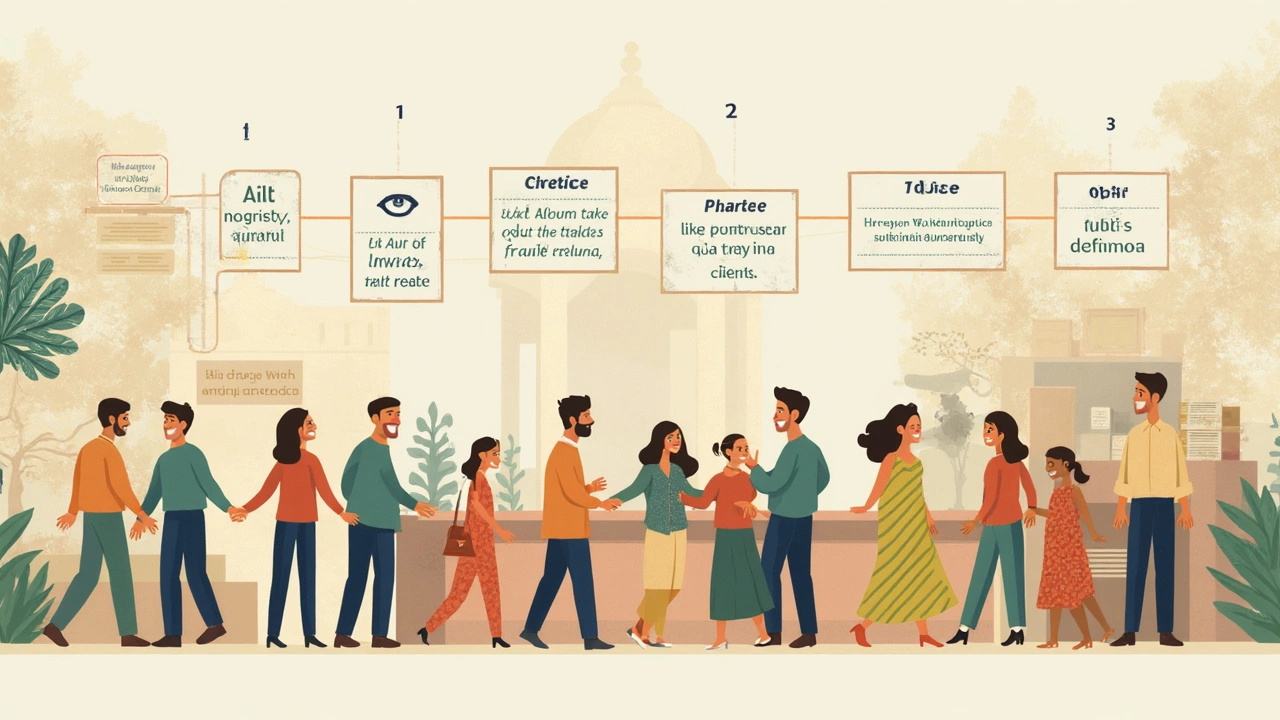If you think civil court is anything like those courtroom dramas on TV, well, most of it isn’t. There’s no shouting or people storming out. Civil cases usually mean one person says the other owes them money, property, or did them wrong in some way—not crimes, just personal beefs that need a formal fix.
Easiest way to picture it? Say your neighbor’s tree falls on your car and they won’t pay to fix it. You might take them to civil court. Or maybe it's about a dodgy contractor, an unpaid loan, or even a landlord that kept your deposit for no good reason. Civil court is all about sorting out who is right, who is wrong, and who (if anyone) needs to pay up or do something as a result.
The cool thing is, you don’t need to be a lawyer to start a civil case, though it helps. You don’t even need to have seen a courtroom before. What matters most is having your facts straight, evidence (photos, texts, even screenshots help), and a clear story. Most people are surprised to hear that the process is more about paperwork and patience than big showdowns. If you really want to know what happens next, keep reading—straight answers, real tips, and no legal mumbo jumbo.
- How a Civil Case Starts
- The Steps Before Trial
- What Happens During the Trial
- After the Verdict: Next Moves
How a Civil Case Starts
A civil case doesn’t start with drama—it starts with paperwork. The official launch is called the "complaint" or "petition." This short document spells out what went wrong, who you think is at fault, and what you want the court to do about it (usually money or a specific action). You become the "plaintiff." The person you’re suing is the "defendant."
The paperwork isn’t just for show. If you miss details (like the right names, correct dates, or exactly what you’re asking for), your case can get tossed out before it even starts. Courts usually post sample forms online, so no need to guess what it should look like. And honestly, the more specific you are, the better your shot at a fair hearing.
Once you file, your next job is making sure the other side knows they’re being sued. This step is called "serving" the papers. It can’t just be a text or email. Usually you hire a process server or sometimes even have the sheriff deliver it. Without proper service, a judge can’t move your case forward.
After getting served, the defendant usually has a set time (often 20 to 30 days) to officially answer your complaint. If they ignore it, you might win by default. But more often, they write back (called an "answer") and might even counter-sue you. That’s when both sides get pulled into what the court calls "pre-trial" steps—a lot of forms, not much courtroom action yet.
Here’s an idea of how the numbers look in the real world:
| Step | Average Time to Complete | Cost Range (USD) |
|---|---|---|
| Filing the complaint | 1-2 days | $50 - $400 |
| Serving defendant | 1-2 weeks | $35 - $120 |
| Defendant's answer | 20-30 days | Usually free |
If you’re dealing with something under a certain dollar limit—think small claims under $10,000 in lots of states—you can skip the lawyer and just talk to the court clerk for most of this. But for bigger stuff, or tricky cases, it’s smart to get advice. Don’t miss deadlines. Keep copies of absolutely everything. And if you’re not sure if your problem is really “civil,” just call the court—staff usually can’t give advice, but they can point you to the right process.
The Steps Before Trial
So you’ve filed your paperwork and officially started a civil case. Here’s where things get real. There are a few hoops to jump through before you ever see a judge.
First, after filing, the court gives you a stamped copy of your claim. You need to properly serve—or officially deliver—those papers to the person or business you’re suing, called the defendant. No, you can’t just text them a picture. Most states require certified mail, a professional process server, or sometimes the sheriff. If the other side dodges service or ignores the lawsuit, you can still win by something called “default judgment”—meaning you win because they failed to show up or respond.
Next up is the response. The defendant usually has about 20 to 30 days to answer, depending on the local rules. In their response, they’ll admit, deny, or maybe even counter-sue you for something else. This back-and-forth sets the stage for almost everything that happens later.
Now, both sides have to swap evidence—this is called discovery. Think emails, receipts, contracts, photos, or that damaged product. Discovery can drag on for months, especially if lawyers get involved. And yes, both sides can ask each other written questions (“interrogatories”) or request documents. Sometimes, they even take depositions, where you answer questions under oath with a court reporter taking it all down.
Most civil cases end before trial, often because someone blinks and settles. According to the National Center for State Courts, over 70% of civil lawsuits in the U.S. end in an agreement, not a trial. Courts also usually require at least one attempt at settlement, sometimes through mediation or a meeting called a pretrial conference.
| Step | Typical Timeframe |
|---|---|
| Service of Papers | Within days to weeks of filing |
| Defendant’s Response | 20–30 days from service |
| Discovery Phase | 2–9 months, sometimes longer |
| Pretrial Motions/Settlement | Anytime before trial |
One more thing—keep copies of every document and email. You have no idea how often people show up in civil court missing key pieces of evidence. It’s a simple tip but saves a ton of headache.

What Happens During the Trial
So you’ve made it to trial day in your civil case. Unlike the movies, there’s rarely a dramatic reveal. Here's how it usually plays out, step by step.
First, both sides show up at court. It's not always some big courtroom; sometimes, it’s just a regular room in a government building. There’s usually a judge (sometimes a jury, but not always) who listens to both sides.
- The plaintiff (that’s the person who filed the lawsuit) goes first. They explain what happened and what they want.
- They bring out their evidence—think photos, contracts, receipts, text messages, or emails. Anything that backs up the story gets shown off here.
- Next up is witnesses. If you have someone who saw what happened or knows important details, they can be called in to talk. But they can be cross-examined, so both sides get to ask them questions.
- After the plaintiff is done, it’s the defendant’s turn. The defendant shows their own evidence and can bring in their witnesses too.
The judge (or jury) listens, sometimes asks questions, and takes notes. Lawyers (if there are any) will argue their sides, but you don’t need a lawyer to do this—people represent themselves all the time. The judge wants to see proof, not just hear complaints or blame. Stay organized and stick to the facts; that’s what will help your case the most.
Trials usually wrap up faster than criminal cases. You might be done in a couple of hours. Sometimes you have to wait a week or two for a decision, but smaller cases—like in small claims court—often get results the same day.
| Average Trial Length | Decided by Jury | Settlement Before Verdict |
|---|---|---|
| 1-2 days | Less than 10% | About 70% |
You don’t have to talk like a lawyer. Speak clearly, be respectful, and keep it real. Judges have seen everything before, so honesty and straight facts go a long way. If your side wins, the judge will lay out exactly what the other side has to do. If not, you’ll at least know you gave it your best shot. Either way, what matters most is showing up and doing your homework.
After the Verdict: Next Moves
The judge or jury tossed out their decision and now what? A civil case isn’t over the second a verdict lands. Depending on which side you’re on, this is where things either start to feel like a win… or you wonder what you can still do. Don’t leave the courthouse thinking it’s all set in stone. There’s still a bit you need to know about what comes next with your civil case.
If you won, you usually get a written judgment telling the other party what they owe or have to do. Sounds good, but collecting what you’re owed isn't always automatic. Courts don’t chase people around with a checkbook. Instead, it’s up to you to get that money or enforce the decision. If someone won’t pay up, you might have to request a wage garnishment, a bank levy, or a lien on their property. Each state has its own rules on how and when you can do this, and some stuff (like a house someone lives in) can be off limits.
Lost the case? Don’t panic—there’s usually an option to appeal if you truly think a legal mistake was made. Notice the difference: you can't appeal just because you didn’t like the result. Most states give you 30 days to file an appeal, but check the local court’s website to be sure.
Here’s how things usually play out after a verdict:
- Judgment entered: The court makes everything official in writing.
- Enforcing judgment: It’s your job to chase up payment through proper channels if the loser won’t pay.
- Possible appeal: File quickly if you think there’s a good legal reason.
- Collections: Interest can pile up—some states tack on 5-10% per year if the judgment isn’t paid.
Want a look at what collecting a judgment might involve? Here’s a quick breakdown:
| Action | Typical Timeframe | Notes |
|---|---|---|
| Requesting wage garnishment | 2-6 weeks | Amount is capped (usually up to 25% of net pay) |
| Bank account levy | 1-3 weeks after order | Only if there’s enough in the account |
| Placing a lien on property | 1-2 months | Can stay on for years if not paid off |
If the other side files bankruptcy, collecting might get way harder—or impossible. But sometimes certain debts, like unpaid child support or some tax debts, can’t be wiped out even by bankruptcy. So don’t give up hope without checking first.
One last tip: Keep copies of all your court papers and communications. If someone drags their feet on payment, this documentation seriously helps if you ever need to go back to court.


